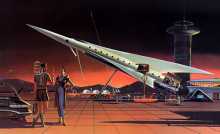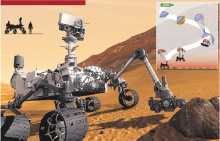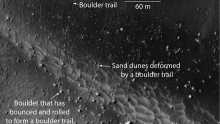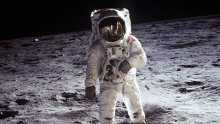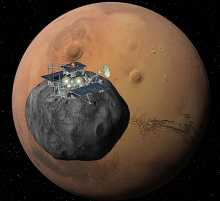Curiosity Landing on Mars is a $2.5 billion gamble for NASA
Landing the rover Curiosity on the Red Planet is going to pose a serious challenge because of the nature of its atmosphere. But this Rover landing which is part of the larger Mars Science Laboratory mission has great goals namely to plan for a possible manned mission to Mars in the future and also to solve the mystery about life on Mars. Additionally, operating Curiosity on the surface of the planet will give more insights into the geology of Mars and its climate.
I was really thrilled when the United States signed a bill two years ago permitting a manned mission to the Red Planet by the 2030s. I guess we really aren’t going to get anywhere near a space colony in my lifetime with all the difficulties that a manned mission to Mars poses. These could be anything from physical effects such as eyesight loss and exposure to high energy cosmic rays to the psychological effects of having to be away from Earth to even things like being unable to get good medical facilities.
Scientists Find Evidence of Marsquakes In Rolling Boulders
Celestial Show: Our Moon, Jupiter, Venus and Mercury light up the sky
For all you space enthusiasts out there, it was a pretty amazing view if you looked up at the sky over the weekend. There was actually a heavenly triangle that had a crescent moon at the top and the gas giant Jupiter and “Queen of the Sky” Venus forming the bases. Jupiter and Venus are in fact the brightest planets in the Solar System.
This celestial show was on again last evening for those of who might have missed it Saturday night. The celestial show can be seen by people across the globe and it is not exclusive to viewers only in a certain location as is the case with a lot of events like this. The closest planet to the Sun, Mercury, will also be seen if you look diligently below Venus close to the horizon.
Newt Gingrich’s Moon Colony
Space enthusiasts like me are wondering what the future of the space program is going to be like and especially with manned space flights and the chance of setting up base outside of our planet. Under the Obama administration, there really has not been much importance place on the space program and it has been dwindling.
In comes Newt Gingrich with his pledge to have a Moon Colony by the end of his second term in office in 2020. I am not a big fan of the former Speaker and most political analysts would agree that his campaign has been mostly negative, but this really feels like music to my ears. But is it really possible is the question on everyone’s minds.
The costs are going to be too much for NASA as it is estimated that even placing a four-person station would cost about $35 billion. Additionally, astronomer Phil Plait who came up with this figure states that it would cost just over $7 billion to keep things going on the Moon base. This will be a problem to convince taxpayers to come up with that kind of money and when looking at the private sector I don’t see any investor who might be willing take this on.
Scientists Drastically Underestimate the Number of Planets in the Milky Way
2011 is the 9th warmest year in recorded history
Before I go further, I want to point out an ad that I shared on another blog on this network of sites. Note the point where Kobe Bryant says that Richard Branson “owns space” at the 0:18 mark. I found it amazing as I was just talking about that not too long ago in this blog.
Anyway, NASA has found that 2011 has been the 9th warmest year since 1880. I live in Minneapolis and I found it strange to have no snow on Christmas and New Year’s Day with temperatures in the 40-50 F range too. Actually, this is just one of those mild winters that occur in Minnesota from time to time.
But in all seriousness, this is actually part of a trend with 9 of the 10 warmest years happening after the turn of the millennium. I am not jumping on the whole global warming bandwagon, but the data seems to point to it. Meteorologists now anticipate the temperature to increase consistently and this should be a good juncture to discuss NASAs test chamber on ‘climate change’ that mimic the toxic conditions of our neighboring planet Venus.
This really goes back to what Carl Sagan talked about in the "Heaven and Hell" episode on the television series Cosmos: A Personal Voyage regarding what people could learn from Venus. There are a lot of lessons that we can glean from this simulation by NASA as many scientists including Sagan believe that Venus was just like Earth several billion years ago. Now Venus is composed of 98 percent carbon dioxide and studying how this happened will help in thwarting a similar fate for our world.
Russians Accuse U.S. Of "Interfering" With Failed Satellite
With characteristically Russian tactlessness, Popovkin attempted to redirect the blame for the mission’s failure, saying that the mission was sabotaged by an anti-satellite weapon. "We don't want to accuse anybody,” he said accusingly, “but there are very powerful devices that can influence spacecraft now." Of course, that’s a bit like saying, “I want to very diplomatically blame the U.S. for disrupting our space mission because they’re the only ones capable of doing it.”
Science fiction becoming a science fact again
I continue with my talk about extraterrestrial life on this blog with this post. It was actually inspired by an article that I read in the Minneapolis StarTribune while eating breakfast this morning about astronomers discovering more signs that supports the idea of numerous planets in the Universe. It basically sheds light on the debate about life outside of our own and makes us realize that we have only just begun looking and just in our backyard (in terms of the size of the universe I mean).
Have $200,000 lying around? Why not take a space flight? Now you can.
According to the New York Times, Virgin Galactic is now selling tickets for space flights for $200K. The flights are scheduled to be this year and at this point just a little less than 500 people have booked seats on this momentous voyage to outer space.
“Hopefully by next Christmas, myself, my daughter and my son will be the first people to go up into space” on a commercial craft, Richard Branson, the owner of Virgin Galactic, said in a videotaped interview in November. $200K is definitely a bargain for such an amazing experience that should await a space tourist and Allianz has even lined up travel insurance for these wealthy space enthusiasts to purchase.
